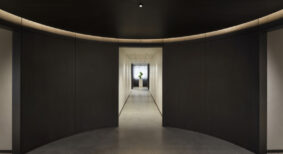It is a growing trend for homeowners to spend time and money in order to create the ideal outdoor environment. Using well-laid-out patio designs and luxurious furniture pieces, including outdoor fireplaces and pits, the backyard can now rival the comfort of any indoor living room.
Many home and business owners are now including an outdoor fireplace or fire pit to not only add warmth, but to create a cozy atmosphere and complete that perfect outdoor aesthetic.
“Our caveman ancestors were not that far off on the purpose of a fire,” says Yves St. Hilaire, owner, designer and artisan at Sticks and Stones Furniture in Squamish, B.C. “Yes, it is primarily there to create heat, but also so you can share a toast with a friend beside its warmth, and maybe roast some marshmallows, too.”
For St. Hilaire, whose company offers a range of custom-made residential and commercial outdoor fireplaces and fire pits, their purpose is all about balancing function with eye-catching design. This can even help a restaurant or bar stand apart from its competition.
“Besides being an aesthetic tool, they offer the patrons a warm experience which helps them stay longer, which in turn means more money for the owners,” he says. “The restaurant and bar business is very competitive, especially in today’s economy, so the antes have all been raised. A well-designed deck with a stunning outdoor fire pit can only help lure (customers) in.”
With so many options out there, though, St. Hilaire likens choosing an outdoor fireplace to choosing a new automobile.
“There are Chevrolet Pintos and then there are Ferraris,” he says. Depending on the buyer’s budget and personal taste, there are products that come in all shapes and sizes. They also come in a range of materials ranging from rough and rugged stone to granite and smooth concrete.
“Outdoor fire pits need to be made from a non-combustible material. Something that can also withstand the elements,” St. Hilaire says. “A fire pit has to use a non-combustible material surrounding the insert, and the insert itself has to be CSA-approved for both home and commercial applications.”
Fireplaces and pits can also use a variety of fuels to produce warmth. St. Hilaire says that buyers should check their city bylaws and relevant fire codes before making a purchase, as there are rules that apply to commercial businesses and residences.
“Before you pick a fire pit, you should look at what fuel is available and recommended in your fire pit location,” he says.
St. Hilaire says that certain types of fire pits, like the wood burning caveman-style models, may not be allowed in populated areas due to safety and pollution reasons. As a result, he explains, the pit may need to burn natural gas, propane or an ethanol fuel. Each has their own pros and cons.
“Natural gas produces a great heat source and strong flames, is easy to light, and is the cheapest burning fuel and is abundant because it’s plumbed to your house,” he says.
However, installing lines can be expensive if they were not included during a home’s construction. St. Hilaire says that this requires a qualified gas fitter to hook it up, something that is not needed with propane or ethanol fire pits.
On the other hand, propane requires the owner to refill tanks frequently. Meanwhile, ethanol is slightly more expensive and it produces less heat and a smaller flame.
But no matter which fuel or design of outdoor fireplace, St. Hilaire says that it will certainly add style, atmosphere and a warm welcome to guests.
“Anything that helps bring your family or friends together is a good thing,” he says.
Steven Hill is a freelance writer in Vancouver.







